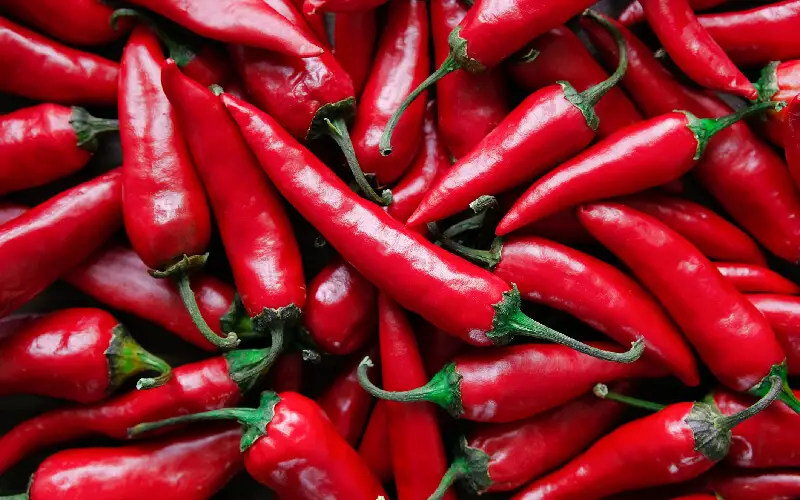
spicy foods
When it comes to spicy foods, we usually either love them or hate them; few say they’re “indifferent” to whether a dish is spicy or not. If you’re not a fan of spicy food, you’ll avoid it altogether, not wanting to feel that warmth and tingling on your tongue. But if you’re a fan, you’ll happily munch on your chili pepper with your lunch or sprinkle spicy seasonings into your favorite dish, enjoying every bit of it. Whether you love or hate spicy foods, we have one question for you – did you know just how spicy can actually be healthy?
What is Capsaicin?
Capsaicin is a naturally occurring compound found in various types of hot peppers, most notably chili peppers. It is responsible for the spicy heat sensation experienced when these peppers are consumed. Chemically, capsaicin belongs to a class of compounds known as capsaicinoids, which are found primarily in the seeds and membranes of chili peppers. Interestingly, the level of capsaicin in a pepper is often correlated with its degree of spiciness, with hotter peppers containing higher concentrations of this compound.
Beyond its culinary use, capsaicin has garnered significant attention for its potential health benefits. Research suggests that capsaicin may possess anti-inflammatory properties, making it potentially useful in managing conditions characterized by inflammation, such as arthritis. Additionally, capsaicin is believed to promote cardiovascular health by improving blood circulation and reducing cholesterol levels. Some studies have also suggested that capsaicin may aid in weight management by increasing metabolism and reducing appetite.
In the field of medicine, capsaicin has found applications in topical treatments for pain relief. Capsaicin creams and patches are commonly used to alleviate discomfort associated with conditions like arthritis, neuropathy, and even post-surgical pain. These products work by desensitizing nerve receptors in the skin, ultimately reducing the sensation of pain. Despite its spicy reputation, capsaicin continues to be a subject of scientific interest due to its potential therapeutic properties across various health conditions.
Click the text to discover the best tips for exercise, nutrition, and top-notch NIKE gear
The Benefits of Spicy Foods
In the realm of culinary delights, spicy foods hold a special place, tantalizing taste buds and igniting a fiery sensation that adds zest to any dish. Beyond their flavorful appeal, spicy foods boast a myriad of health benefits that might surprise you. From boosting metabolism to enhancing heart health, the benefits of incorporating spicy foods into your diet are as diverse as they are delicious. Let’s delve into the spicy world of culinary delights and uncover the secrets behind their health-enhancing properties.
Metabolism Booster Extraordinaire
Spicy foods contain a compound called capsaicin, responsible for their characteristic heat. Capsaicin not only adds a kick to your meals but also revs up your metabolism, leading to increased calorie burning. Studies have shown that capsaicin can temporarily boost metabolic rate, aiding in weight management and fat loss efforts.
Moreover, spicy foods may promote a feeling of fullness and satiety, potentially curbing appetite and reducing overall calorie intake. By incorporating spicy foods into your diet, you may harness the metabolic-boosting powers of capsaicin to support your weight loss journey and achieve your health goals.
Heart Health Champion
Contrary to popular belief, spicy foods can be a boon for heart health. Capsaicin has been shown to possess anti-inflammatory properties, which may help reduce the risk of heart disease by lowering levels of inflammation in the body. Additionally, spicy foods may have a positive impact on cholesterol levels, with some studies suggesting that capsaicin may increase levels of “good” HDL cholesterol while decreasing levels of “bad” LDL cholesterol.
Furthermore, the vasodilatory effects of capsaicin may promote healthy blood flow and circulation, supporting cardiovascular function. By incorporating spicy foods into your diet, you not only tantalize your taste buds but also nourish your heart, reaping the benefits of a flavorful and heart-healthy eating pattern.
Immune System Supporter
Spicy foods have long been revered for their immune-boosting properties, thanks to the presence of various potent compounds. Capsaicin, in particular, exhibits antimicrobial properties that may help fend off harmful bacteria and pathogens, bolstering the body’s defenses against infections.
Moreover, the heat generated by spicy foods can induce sweating, which serves as a natural detoxification mechanism, helping to flush out toxins from the body and support immune function. Additionally, the abundance of vitamins and antioxidants found in many spicy ingredients, such as chili peppers, garlic, and ginger, further fortifies the immune system, enhancing resilience against illness and disease.
Pain Reliever Extraordinaire
Believe it or not, spicy foods can serve as natural pain relievers, offering relief from various ailments. Capsaicin has been shown to inhibit the transmission of pain signals in the body, making it a valuable ally in the management of conditions such as arthritis, neuropathy, and migraines.
Furthermore, the heat generated by spicy foods can trigger the release of endorphins, the body’s natural painkillers, providing temporary relief from discomfort and promoting a sense of well-being. By incorporating spicy foods into your diet, you may harness the analgesic properties of capsaicin to alleviate pain and enhance your overall quality of life.
Mood Enhancer and Stress Buster
Spicy foods are not only a treat for the taste buds but also a boon for mental well-being. The fiery sensation elicited by spicy foods can stimulate the release of endorphins, neurotransmitters that promote feelings of happiness and euphoria, akin to the “runner’s high” experienced during exercise.
Moreover, the heat of spicy foods may activate the sympathetic nervous system, triggering a stress response that can help alleviate tension and promote relaxation. By indulging in spicy culinary delights, you not only satisfy your cravings but also uplift your mood and banish stress, savoring the spicy joys of life to the fullest.
Make Your Own Homemade Tabasco Sauce
Ingredients:
1 cup of apple cider vinegar
250 grams of hot peppers (e.g., chili peppers, habanero, jalapeño)
2 cloves of garlic, finely chopped
1 teaspoon of salt
1 teaspoon of sugar
Instructions:
Prepare the peppers: Wash them and remove the stems. You can leave them whole or halve them to make them easier to blend.
Place the peppers and finely chopped garlic in a blender or food processor. Blend until you get a smooth mixture.
Transfer the mixture to a cooking pot and add the apple cider vinegar, salt, and sugar. Stir well.
Place the pot on the stove and cook over medium heat. Once the mixture starts to boil, reduce the heat and simmer for about 10-15 minutes, stirring occasionally.
Remove the pot from the heat and let the sauce cool to room temperature.
Once the sauce has cooled, strain it through a fine sieve to remove any larger pieces of pepper and garlic.
Transfer the sauce to a glass bottle or flask using a funnel. Store it in the refrigerator.
Note: You can adjust the amount of peppers according to your taste and desired level of spiciness. Additionally, lemon juice or other seasonings such as chili powder or black pepper can be added for extra flavor. Enjoy your homemade Tabasco sauce!
Plant Fibers: Your Best Ally in the Fight Against Extra Pounds
Cellulite: A Nightmare That Has a Cure
Discover the latest fashion trends and beauty secrets! Click for a dose of inspiration!


